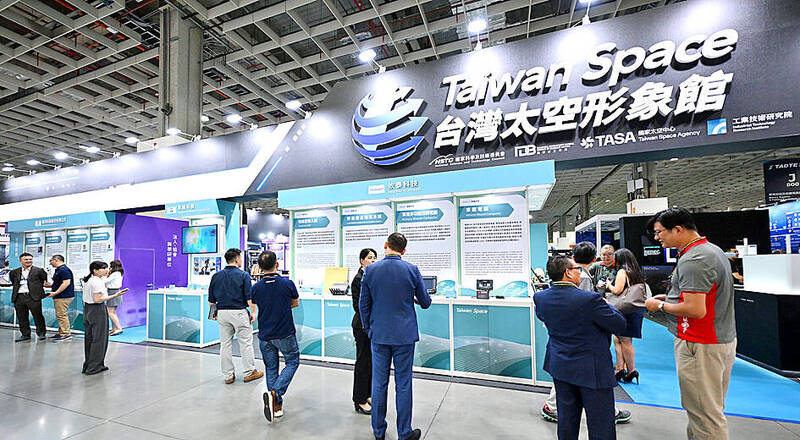《TAIPEI TIMES》 TASA to launch six satellites from 2026

The Taiwan Space booth at the Taipei Aerospace & Defense Technology Exhibition in Taipei is pictured in an undated photograph. Photo courtesy of the Industrial Technology Research Institute
SELF-SUFFICIENCY: The project would only be the beginning, as Taiwan needs at least 120 satellites to ensure uninterrupted communication, Wu Tsung-tsong said
/ Staff writer, with CNA
The Taiwan Space Agency (TASA) yesterday said it plans to launch six low Earth orbit satellites starting in 2026 as part of the government’s plan to boost the resilience of the nation’s communications.
The development of the technology gained attention after Ukrainians were able to access the Internet through Space Exploration Technologies Corp (SpaceX) CEO Elon Musk’s Starlink satellite service, despite their infrastructure being severely damaged in the war with Russia.
Two of the satellites would be built by the government, while four would involve cooperation between TASA and private contractors.
“Over the past 30 years, the satellite technology in Taiwan has mostly been used for remote sensing and meteorological observations,” National Science and Technology Council Minister Wu Tsung-tsong (吳政忠) said.
“The research and development of communications satellite technology is indeed challenging, as it is complicated and fast-changing. As such, the government needs to take the lead, which is why it has extended the Phase III space project to 2031 and added NT$40 billion [US$1.23 billion] to the budget,” he said.
TASA Director-General Wu Jong-shinn (吳宗信) said the agency plans to launch the first low Earth orbit satellite in 2026 using a SpaceX rocket and the second one in 2028.
The first satellite’s body would be made in Taiwan, but the Ka bend communication payload would be built in partnership with an overseas contractor, he said.
The second satellite would be jointly developed by the Industrial Technology Research Institute, which is capable of developing 4G and 5G systems, and TASA, Wu Jong-shinn said.
The total budget to launched the two rockets is NT$900 million, he said, adding that the agency hopes that the contracts for the four other satellites will be placed on auction this year.
Aside from Starlink, there are other low Earth orbit satellite service providers, many of whom are eager to set up ground stations in Taiwan.
“However, we have to try to develop the technology ourselves. That way, we would not be worried if some companies refuse to transfer it to us,” Wu Jong-shinn said.
The launch of the six low Earth orbit satellites, known as project “Beyond 5G (B5G),” would only be the beginning, Wu Tsung-tsong said.
Simulations have shown that if there are two low-orbit communication satellites, they would only hover over Taiwan for three to five minutes when orbiting the Earth, he said.
“To achieve uninterrupted communication 24 hours a day, it is obvious that six satellites would not be enough. Taiwan needs at least 120 satellites to build communications resilience,” he said.
The next step is to build up the satellite communications industry, which not only includes existing electronics industry operators, but also new entrepreneurs, Wu Tsung-tsong said.
“They will see that telecommunications business opportunities in the next 10 or 20 years will be in space,” he said.
“Taiwan’s space ground equipment industry is already of considerable scale, with an output value exceeding NT$200 billion, but there is still a lot of room for growth in satellite manufacturing, rocket launch services and other fields,” he said. “Like a baseball player who can pitch and hit, Taiwan must be skilled on the ground and in space.”
新聞來源:TAIPEI TIMES


















